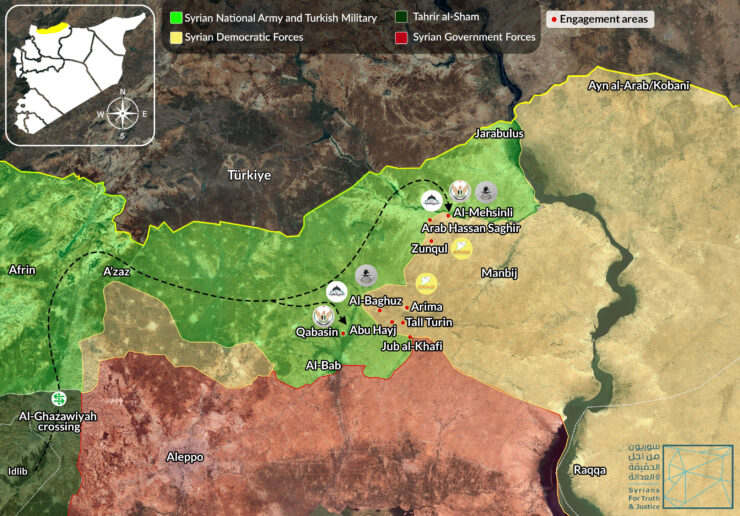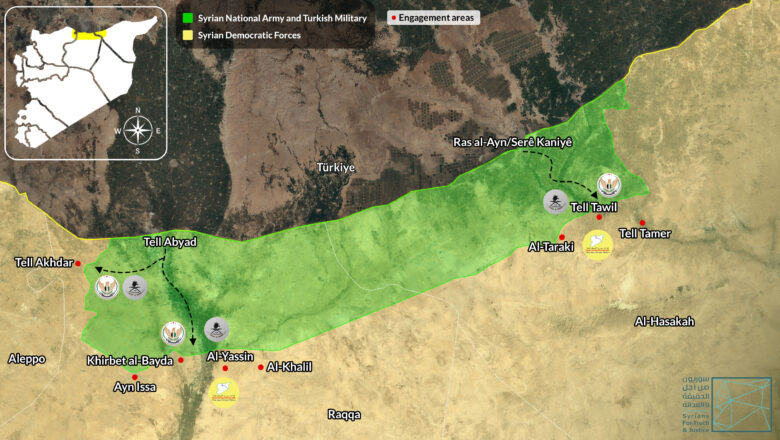Taking advantage of Deir ez-Zor’s unrest between the Syrian Democratic Forces (SDF) and its Deir ez-Zor Military Council on the one hand and Arab tribes on the other, the Hay’at Tahrir al-Sham (HTS), sent hundreds of troops and dozens of military armored vehicles to the northwestern front of Manbij. The military convoy arrived from HTS-held areas in Idlib through the al-Ghazawiyah crossing separating Idlib and “Olive Branch” areas, taken over by Türkiye and the allied Syrian National Army (SNA) in 2018.
After they entered the Euphrates Shield strip, the HTS-deployed fighters continued to expand in the area and established a permanent presence at the al-Hamaran internal crossing. The crossing was taken over after the HTS dispatched hundreds of additional fighters through the Afrin region. Notably, the crossing links the SDF- and SNA-held areas and is the only supply route for fuel coming from northeastern Syria.
Notably, on 14 May 2014 the US State Department designated al-Nusra Front as a terrorist organization pursuant to Executive Order 13224. On 31 May 2018, the Department of State amended the designation of al-Nusra Front to include HTS and other aliases. On 5 July of the same year, the Security Council Committee concerning the Islamic State (IS/Da’esh) and al-Qaeda, amended its sanction list to change the name of al-Nusra to Hay’at Tahrir al-Sham.
The arrival of HTS troops at Manbij fronts was followed by an influx of hundreds of Arab tribes’ fighters and others affiliated with opposition armed groups mainly Harakat al-Tahrir wa-l-Binaa/Liberation and Construction Movement (LCM) consisting of the factions; Gathering of Free Men of the East/Tajammu Ahrar al-Sharqiya, led by Abu Hatem Shaqra, the Eastern Army/Jaysh al-Sharqiya, led by Major Hussein Hamadi, and the 20th Division, led by Abu Barzan al-Sultani.
Sources met by Syrians for Truth and Justice (STJ) confirmed that the HTS fighters who came from Idlib coordinated with the al-Hamza/al-Hamzat Division and Suleiman Shah Brigade (also known as al-Amshat) to access Manbij front through their areas in Afrin. Notably, the U.S. recently designated the latter as terrorist groups over serious human rights abuses they committed in Afrin against the original population.
Other sources told STJ that the HTS sent fighters of al-Nukhba forces, part of Abnaa al-Sharqiya bloc, with the aim of using Deir ez-Zor unrest to expand its control over northern rural Aleppo. It is relevant to recall that earlier, the HTS took advantage of the infighting among Syrian armed opposition groups to expand its presence in Afrin, which scaled up even more after the devastating Syria-Türkiye quake of February 2023.
| This summary report is one of a series of reports STJ plans to publish on the recent military developments following the dismissal of Ahmed al-Khabeel, nicknamed Abu Khawla, former leader of Deir-ez-Zor Military Council of the SDF. Forthcoming reports will be centered on alleged human rights violations committed during the military operations, as well as hate speech, media mobilization, disinformation, and dissemination of fake news. |
For the purpose of this report, STJ interviewed eight sources including locals, media workers as well as SNA commanders and officers who witnessed the arrival of HTS troops to Manbij. For a more in-depth look, STJ sent a field researcher to the hotspot to monitor the expansion of the HTS and learn closely about how it used the influx of Arab tribes’ fighters for its interest. A commander explained to STJ,
“Not as reported, HTS fighters did not enter Manbij on 6 September 2023. In the first days of the Deir ez-Zor unrest, the HTS sent fighters with members of the al-Hamza Division and Suleiman Shah Brigade to observe and monitor Manbij’s fronts. Afterward, small troops began arriving at the northern fronts in Manbij, south of Jarabulus city, and others were set at the Qabasin pivot in rural al-Bab city.”
The source confirmed that the HTS fighters used the headquarters of the al-Hamza Division and the eastern sector of the Islamic Movement of the Free Men of the Levant/Harakat Ahrar al-Sham al-Islamiyya (locally known as Ahrar Awlan) for camouflage. Notably, this was affirmed by sources met by the opposition-run Syria TV.
The same source added,
“When the HTS leaders learned that Türkiye did not mind conducting military operations in Manbij, they sent huge military convoys toward the fronts there under the cover of Arab tribes. Most of the convoys got there on 5 September 2023, including a big one positioned at the Qabasin pivot. The following day, on 6 September, HTS fighters along with others of the al-Hamza Division and the eastern section of the Islamic Movement of the Free Men of the Levant launched a surprise attack on villages in west Manbij.”
STJ crosschecked information provided by the sources met for this report and concluded that the HTS sent 700 to 1000 fighters in addition to about 200 military vehicles, equipped with various types of light and medium weapons, to Manbij fronts. Sources also confirmed seeing HTS’ chief of security, Abu Ahmed Hudud, and the Sharia head and member of HTS’ Shura Council, Mazhar al-Wais on the fronts.
STJ touched out to a media worker who was present on Manbij’s northwestern front to verify these figures. He said,
“The convoys that came from Idlib were definitely of the HTS. The latter tried to delude the public that it was responding to calls from Arab tribes to fight alongside them against the SDF in order to establish a military presence on Manbij fronts.”
The source added that he spoke to HTS fighters and witnessed the influx of hundreds of them to the area under the pretext of responding to the tribes’ appeal taking advantage of the chaos that followed Deir ez-Zor unrest. The source noted that he was astonished to see new and sealed military equipment held by the HTS fighters while humanitarian aid fails to access civilians in northwestern Syria, especially Idlib.
The source concluded that locals in rebel-held areas are concerned over the rapid spread of HTS fighters in northern Syria, and they suggest that the HTS aims to establish a permanent presence in the area and suffocate areas of the SNA.
STJ sent a field researcher to the area in order to verify the information obtained, especially on the deployment of hundreds of HTS fighters in Manbij surroundings. The researcher confirmed that the HTS expanded under the cover of the Arab tribes and in the names of Division 50th and al-Shahba Gathering/Tajammu al-Shahba. [1] The HTS also used the headquarters of the Division 50th and Ahrar Awlan.
An unnamed military commander explained to STJ the background to the influx of rebel factions’ fighters to Manbij front following the announcement of a general mobilization by Sheikh Ibrahim al-Havel, a prominent figure of the Al-Uqaydat tribe in Deir ez-Zor.
“After the announcement of the mobilization, a large number of fighters from Syria’s eastern region headed to the headquarters of their factions, mainly those operating under the LCM, which are the Gathering of Free Men of the East, the Eastern Army, and the 20th Division.”
According to the same sources, Türkiye did not give the leaders of these factions the green light to launch a military operation because of its commitment to understandings agreed with Russia about these areas. This made fighters feel frustrated, as Türkiye would not provide artillery nor air cover for their military actions and would not supply them with weapons and ammunition. The commander said,
“In the days that followed, Türkiye became milder and gave the green light to the factions to launch ground attacks against the positions of the SDF and Manbij Military Council (MMC). Türkiye even provided the factions with information, maps, and aerial images from drones.”
It is relevant to note that military groups consisted of fighters from Arab tribes, Syrian armed opposition factions, and the HTS conducted attacks against villages and towns to the north and west of Manbij. In the north, the clashes were concentrated in the villages of, Arab Hassan Kabir, al-Mahmoudiyah, Tal Syriatel, and Al-Muzhaisinli while in the west that was in the villages of al-bughaz, al-Buheej, Tall Turin, and the road to Arima point.
Opposition media confirmed the influx of HTS troops into northern rural Aleppo under the cover of the Arab tribes. On 6 September 2023, Syria TV reported the arrival of HTS troops in Idlib and their positioning in rural al-Bab and Jarabulus, eastern Aleppo. According to the report, the HTS fighters were stationed in the headquarters of the eastern sector of the Islamic Movement of the Free Men of the Levant and in those of the U.S.-designated terrorist groups the al-Hamza Division and the Suleiman Shah Brigade. In the same vein, a report by Enab Baladi published on 6 September 2023 said that HTS fighters claimed that they intervened in response to appeals of Arab tribes and they are fighting in their name not in their faction’s or any other.
STJ spoke to a military expert who believes that the HTS has a plan to expand outside Manbij into northern rural Aleppo, capture frontlines with the SDF, and thus reach “Peace Spring” areas. Additionally, the HTS covets al-Bab and A’zaz because its presence there allows it to fully control all areas currently under Turkish-backed warring Syrian rebel factions.

Image 1- A map drawn by STJ illustrates the HTS’ expansion in Manbij.
 Image 2- A map drawn by STJ illustrates the areas in which clashes took place between the Arab tribes and the SDF.
Image 2- A map drawn by STJ illustrates the areas in which clashes took place between the Arab tribes and the SDF.
[1] The Division 50th is part of the SNA’s 3rd Corps.

